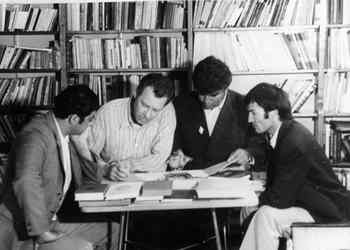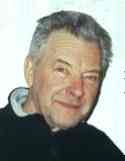

In Memoriam
Vitaly Ivanovich Khalturin
Vitaly Khalturin, a pioneering seismologist with encyclopedic knowledge of regional seismic signals, and a mentor and friend of seismologists around the world, died on 17 April, 2007, in Stanford, California, four days after suffering a major stroke.
Born on 15 August, 1927, in Leningrad, USSR, Vitaly grew up in war-torn and politically tumultuous surroundings. His father was a writer well known in Russian literary circles, and from childhood on, Vitaly knew many prominent Russian authors. While still a student at the University of Leningrad he married a fellow student, Tat’yana Glebovna Rautian. After receiving their Masters degrees in 1951, the two moved to Central Asia as part of the Complex Seismological Expedition (CSE) of the USSR’s Academy of Sciences' Institute of Earth Physics, where they would work together for more than forty years.
Vitaly and Tat’yana spent their early years in Garm, Tajikistan, building CSE’s network of seismographic stations. Far from any libraries or centers of science, they were forced to learn for themselves — from first principles in classical physics — how to design experiments and interpret seismograms. Under harsh economic circumstances, they installed and maintained an extended seismic network. They taught generations of students — from Russia, Armenia, Georgia, and each of the Central Asian republics — the rigors and joys of earthquake studies. It is remarkable that years later the quality of their work has turned out to be so informative to research groups operating with fewer obstacles and far greater resources.
Together with Igor L. Nersesov, who led the CSE for many years, Vitaly and Tat’yana pioneered several large-scale projects in seismic data acquisition and analysis. In his role as first head of the Garm station from 1951-56, Vitaly helped establish one of the world's first laboratories dedicated to the long-term study of earthquake prediction. He broke through logistical barriers to build one of the world's most complete records of seismicity recorded by a local seismic network, from the 1950s to the 1990s, developing methods now widely applied by regional network operators across the former Soviet Union.
Vitaly was also part of the major effort to acquire and interpret long-range refraction profiles in Central Asia. At one point, CSE had more than forty drivers in support of numerous temporary stations stretching over several thousand km to record both earthquakes and nuclear explosions.
Beginning in 1961 a unique seismometric system called ChISS (an acronym for the Russian words for “Frequency Selective Seismograph System”) was installed in 26 stations from the Caucasus Mountains to Lake Baikal. Vitaly used ChISS for many years in his intensive studies. The system recorded broadband seismic signals that were displayed in several different frequency bands, all carefully chosen and shaped, enabling a systematic scientific analysis of spectral content long before digital seismology was born. A ChISS recording of the Soviet Union's first underground nuclear explosion (11 October, 1961) may be seen in Khalturin et al. (Pure and Applied Geophysics, 158, pp 154-5, 2001). When seismologists from western countries began to visit Soviet Central Asia in the 1970s, they recognized that there was much for them to learn from these pioneering projects.
The Tajik civil war of the early1990s brought death and destruction to the CSE in Garm, and Vitaly and Tat’yana were forced to move. They immigrated to the United States, where they worked first at Indiana University and later, from 1993 until their retirement in 2005, at the Lamont-Doherty Earth Observatory of Columbia University.
In the Soviet Union, Vitaly studied the travel time and frequency-dependent characteristics of the main regional and teleseismic phases out to 3500 km distance through extraordinarily detailed observation of thousands of seismograms each year in Central Asia and elsewhere. His Ph.D. thesis (advised by Nersesov) was a study of the amplitudes and periods of regional waves. He and Tat’yana Rautian chose to study seismic coda, an enigmatic part of the earthquake record that most seismologists ignore. They developed robust methods of magnitude determination from measurements made on coda amplitude, as well as methods to obtain the spectrum of different types of seismic source from the coda. Vitaly and his students discovered that the spectral ratio of regional P- and S-waves above 5 Hz is an effective discriminant between earthquakes and explosions. With colleagues, he investigated variations in dynamical properties of Lg-waves across Central Asia, including their blockage by major changes in crustal thickness. He showed that Lg-waves were routinely generated by deep earthquakes in the Hindu Kush. He confirmed for the leaders of the city of Semipalatinsk that damage in their city was being caused by ground shaking due to nuclear explosions at the Semipalatinsk Test Site (STS); the damage was due to that city’s location at the critical distance of Pn generation and near Pn and Pg crossover.
Later, he developed methods of microzoning for strong ground motion using studies of coda waves from small events.
In the US, Vitaly systematically studied regional and teleseismic signals from all 340 reported underground nuclear explosions at STS and demonstrated that virtually all of the explosions with announced yields above two tons produced well-recorded seismic signals. He was the key contributor to a large study of methods to improve estimates of source location throughout East Asia, using data from the new International Monitoring System of the Comprehensive Nuclear-Test-Ban Treaty Organization.
Following the halcyon years of perestroika and glasnost, he was able to obtain information on the development of nuclear testing at Novaya Zemlya and Semipalatinsk. He described in detail the way in which 265 megatons of nuclear explosive energy were released at Novaya Zemlya from 1955 to 1990 — an activity that was an essential component of the USSR's status as a superpower.
Seismologists must sometimes work around the edges of catastrophe — a devastating earthquake, or the effects of nuclear test explosions. Vitaly felt deeply responsible to record the damage resulting from earthquakes and to improve the information that could be obtained from seismic signals about nuclear explosion locations and yields. He organized international meetings to report studies of seismic risk and hazard mitigation in Central Asia. He worked hard to collect historical data on the extent of damage from devastating earthquakes and found reliable information for human losses in China, Japan, India, and Central Asia. He studied the magnitude-yield relation for chemical and nuclear explosions worldwide, examined the problems of mine blasting in the context of nuclear explosion monitoring, and developed new methods of discrimination.
We remember Vitaly as much more than an extraordinarily productive research seismologist. His fascination with linguistics not only made him an autodidact in English, which he learned from listening to the radio, but an avid etymologist in several languages. A man never comfortable being served by others, Vitaly was continually on his feet when given opportunities to provide service. He took a generation of brash young visiting American seismologists in the 1970s under his wing, gently educating them about Central Asian seismology, Soviet history, Russian poetry, and, even, American literature. He was, in his words, a “translator from mentality to mentality,” who, during the height of Stalin-era efforts to bring technology and central planning to Central Asia, befriended peasants in villages surrounding Garm, learned the local dialect of Farsi, promoted literacy and modern learning through the local libraries, and for this and his infectious personality received a hero’s welcome whenever he entered a neighboring village. We shall miss his radiating sparkle, personal warmth, intellectual curiosity, playful disrespect for bureaucracy, intense interest in people’s stories, and his loves of music, literature, and his large family.
Readers can learn more of Vitaly's work and life, and can contribute additional comments and photos, via
http://www.LDEO.columbia.edu/res/div/sgt/vitaly_khalturin.Michael Hamburger (Indiana University), Yuri Kopnichev (Complex Seismological Expedition, Kazakhstan), Anatoli Levshin (University of Colorado), Vladislav Martynov (University of California, San Diego), Natalya Mikhailova (National Data Centre, Kazakhstan), Peter Molnar (University of Colorado), Paul G. Richards (Lamont-Doherty Earth Observatory of Columbia University), Steve Roecker (Rensselaer Polytechnic Institute), David Simpson (The IRIS Consortium), Brian E. Tucker (GeoHazards International), Robert Wesson (U.S. Geological Survey)

Vitaly Khalturin in 1976, working at home with graduate students in Garm, Tajikistan (photo by T. Rautian).
|
|